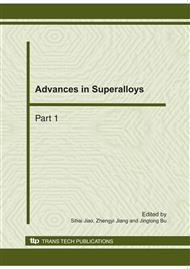[1]
Robert R. Matheson Jr. 20th- to 21st-Century Technological Challenges in Soft Coatings. Science,297(5583), 976 – 979(2002).
DOI: 10.1126/science.1075707
Google Scholar
[2]
C. Decker, F. Masson,R. Schwalm. Weathering resistance of waterbased uv-cured polyurethane-acrylate coatings, Polymer Degradation and Stability 83 (2004)309-320.
DOI: 10.1016/s0141-3910(03)00276-3
Google Scholar
[3]
Z.W. Wicks F.N. Jones S.P. Pappas, Organic Coatings Science and Technology. The publication of chemical industry,Beijing, (2002).
Google Scholar
[4]
R.P. Singh, Namrata S. Tomer, Veera Bhadraiah. Photo-oxidation studies on polyurethane coating: effect of additives on yellowing of polyurethane, Polymer Degradation and Stability 73 (2001)443-446.
DOI: 10.1016/s0141-3910(01)00127-6
Google Scholar
[5]
Pilar Garcia Parejo, Marcos Zayat, David Levy. Highly efficient UV-absorbing thin-film coatings for protection of organic materials against photodegradation, J. Mater. Chem. 16 (2006) 2165–2169.
DOI: 10.1039/b601577h
Google Scholar
[6]
C.A. Peters, K.R. Ellwood, Y. Srivastava, et al. Ultraviolet light absorber mobility in crosslinked coatings: Experiments and modeling, Progress in Organic Coatings 58 (2007) 272–281.
DOI: 10.1016/j.porgcoat.2006.12.004
Google Scholar
[7]
B. Xiang, H.Y. He, R.Q. Zhu, S.T. Zhang.an ultraviolet absorbent and the synthetic method[P].CN:200910104531. 4.
Google Scholar
[8]
Fraaije, J. G. E. M. J. Chem. Phys., 1993, 99: 9202.
Google Scholar
[9]
Shelley, J. C.; Shelley, M. Y. Curr. Opin. Colloid Interface Sci. 2000, 5, 101.
Google Scholar
[10]
Fraaije, J. G. E. M.; van Vlimmeren, B. A. C.; Maurits, N. M.; Postma, M.; Evers, O. A.; Hoffman, C.; Altevogt, P.; Gold-beck-Wood, G. J. Chem. Phys., 1997, 106: 4260.
Google Scholar
[11]
van Vlimmeren, B. A. C.; Maurits, N. M.; Zvelindovsky, A. V.; Sevink, G. J. A.; Fraaije, J. G. E. M. Macromolecules, 1999, 32: 646.
Google Scholar
[12]
Lam, Y. M.; Goldbeck-Wood, G. Polymer, 2003, 44: 3593.
Google Scholar
[13]
Lam, Y. M.; Goldback-Wood, G.; Bothroyd, C. Molecular Simulation, 2004, 30: 239.
Google Scholar
[14]
Guo, S. L.; Hou, T. J.; Xu, X. J. J. Phys. Chem. B, 2002, 106: 11397.
Google Scholar
[15]
Li, Y.; Hou, T.; Guo, S.; Wang, K.; Xu, X. Phys. Chem. Chem. Phys., 2000, 2: 2749.
Google Scholar


